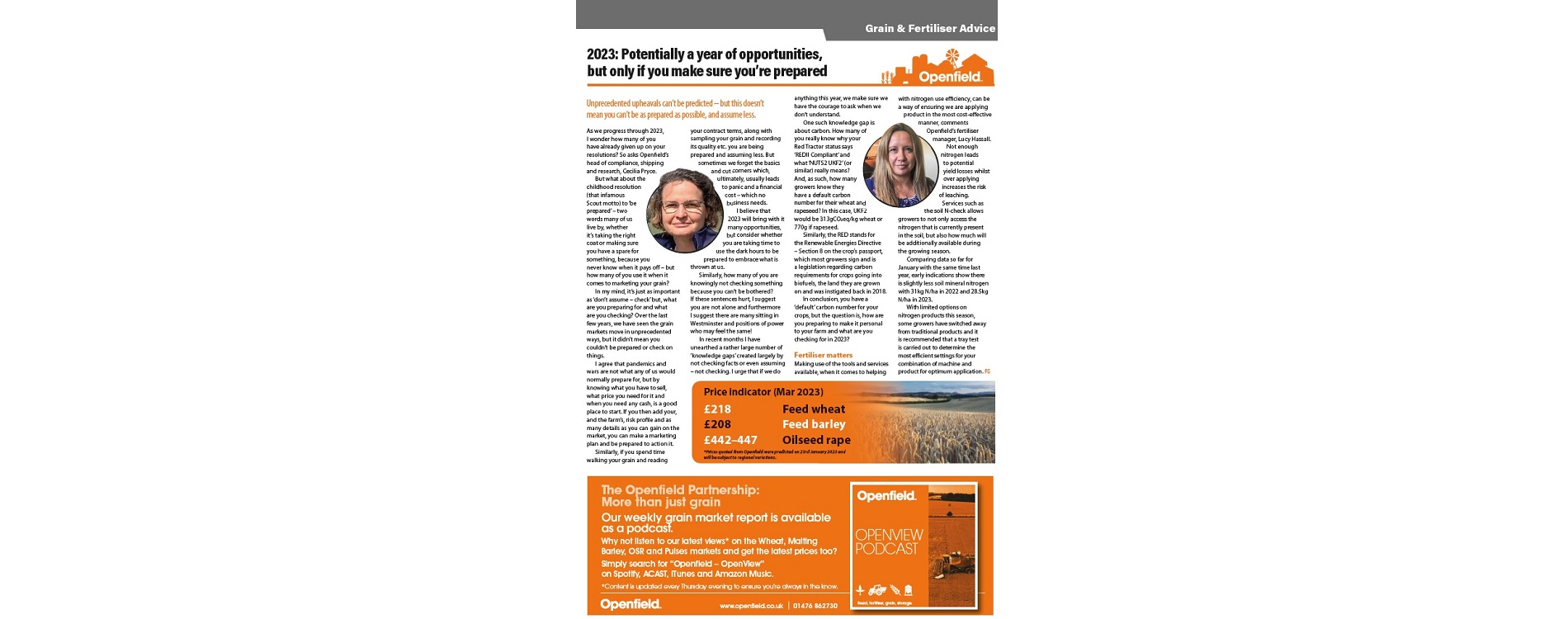2023: Potentially a year of opportunities, but only if you make sure you’re prepared
Unprecedented upheavals can’t be predicted – but this doesn’t mean you can’t be as prepared as possible, and assume less.
As we progress through 2023, I wonder how many of you have already given up on your resolutions? So asks Openfield’s head of compliance, shipping and research, Cecilia Pryce. But what about the childhood resolution (that infamous Scout motto) to ‘be prepared’ – two words many of us live by, whether it’s taking the right coat or making sure you have a spare for something, because you never know when it pays off – but how many of you use it when it comes to marketing your grain? In my mind, it’s just as important as ‘don’t assume – check’ but, what are you preparing for and what are you checking? Over the last few years, we have seen the grain markets move in unprecedented ways, but it didn’t mean you couldn’t be prepared or check on things.
I agree that pandemics and wars are not what any of us would normally prepare for, but by knowing what you have to sell, what price you need for it and when you need any cash, is a good place to start. If you then add your, and the farm’s, risk profile and as many details as you can gain on the market, you can make a marketing plan and be prepared to action it. Similarly, if you spend time walking your grain and reading your contract terms, along with sampling your grain and recording its quality etc. you are being prepared and assuming less. But sometimes we forget the basics and cut corners which, ultimately, usually leads to panic and a financial cost – which no business needs. I believe that 2023 will bring with it many opportunities, but consider whether you are taking time to use the dark hours to be prepared to embrace what is thrown at us. Similarly, how many of you are knowingly not checking something because you can’t be bothered? If these sentences hurt, I suggest you are not alone and furthermore I suggest there are many sitting in Westminster and positions of power who may feel the same! In recent months I have unearthed a rather large number of ‘knowledge gaps’ created largely by not checking facts or even assuming – not checking. I urge that if we do anything this year, we make sure we have the courage to ask when we don’t understand.
One such knowledge gap is about carbon. How many of you really know why your Red Tractor status says ‘REDII Compliant’ and what ‘NUTS2 UKF2’ (or similar) really means? And, as such, how many growers know they have a default carbon number for their wheat and rapeseed? In this case, UKF2 would be 313gCO eq/kg wheat or 770g if rapeseed.
Similarly, the RED stands for the Renewable Energies Directive – Section 8 on the crop’s passport, which most growers sign and is a legislation regarding carbon requirements for crops going into biofuels, the land they are grown on and was instigated back in 2018. In conclusion, you have a ‘default’ carbon number for your crops, but the question is, how are you preparing to make it personal to your farm and what are you checking for in 2023?
Fertiliser matters
Making use of the tools and services available, when it comes to helping with nitrogen use efficiency, can be a way of ensuring we are applying product in the most cost-effective manner, comments Openfield’s fertiliser manager, Lucy Hassall. Not enough nitrogen leads to potential yield losses whilst over applying increases the risk of leaching. Services such as the soil N-check allows growers to not only access the nitrogen that is currently present in the soil, but also how much will be additionally available during the growing season. Comparing data so far for January with the same time last year, early indications show there is slightly less soil mineral nitrogen with 31kg N/ha in 2022 and 28.5kg N/ha in 2023.
With limited options on nitrogen products this season, some growers have switched away from traditional products and it is recommended that a tray test is carried out to determine the most effcient settings for your combination of machine and product for optimum application.




